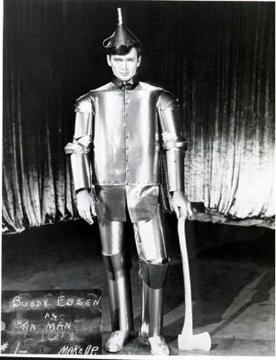The Wizard of Oz
The Wizard of Oz
The Wizard of Oz is a 1939 American musical film produced by Metro-Goldwyn-Mayer. It is an adaptation of L. Frank Baum's 1900 children's novel The Wonderful Wizard of Oz. The film stars Judy Garland as Dorothy Gale, alongside Ray Bolger, Jack Haley, and Bert Lahr. The story follows Dorothy, a young girl from Kansas, who is swept away by a tornado to the magical land of Oz.
Plot[edit | edit source]
The film begins in Kansas, where Dorothy Gale lives with her Aunt Em and Uncle Henry. After a tornado hits, Dorothy and her dog Toto are transported to the land of Oz. They follow the Yellow Brick Road to the Emerald City to meet the Wizard of Oz, who they believe can help them return home.
Along the way, they befriend the Scarecrow, who desires a brain; the Tin Man, who wants a heart; and the Cowardly Lion, who seeks courage. They face various challenges, including the Wicked Witch of the West, who wants Dorothy's magical ruby slippers.
Cast[edit | edit source]
- Judy Garland as Dorothy Gale
- Ray Bolger as the Scarecrow
- Jack Haley as the Tin Man
- Bert Lahr as the Cowardly Lion
- Margaret Hamilton as the Wicked Witch of the West
- Frank Morgan as the Wizard of Oz
Production[edit | edit source]
The film was directed by Victor Fleming, with uncredited contributions from George Cukor and Mervyn LeRoy. The screenplay was adapted by Noel Langley, Florence Ryerson, and Edgar Allan Woolf. The music was composed by Harold Arlen, with lyrics by E.Y. Harburg.
Legacy[edit | edit source]
The Wizard of Oz is considered one of the greatest films in cinema history. It was nominated for six Academy Awards, including Best Picture, and won two, including Best Original Song for "Over the Rainbow". The film has been preserved in the National Film Registry by the Library of Congress.
Cultural Impact[edit | edit source]
The film has had a significant impact on popular culture, with its characters, music, and quotes becoming iconic. The phrase "There's no place like home" and the song "Over the Rainbow" are particularly well-known.
See Also[edit | edit source]
References[edit | edit source]
External Links[edit | edit source]
Transform your life with W8MD's budget GLP1 injections from $125 and up biweekly
W8MD offers a medical weight loss program NYC and a clinic to lose weight in Philadelphia. Our W8MD's physician supervised medical weight loss centers in NYC provides expert medical guidance, and offers telemedicine options for convenience.
Why choose W8MD?
- Comprehensive care with FDA-approved weight loss medications including:
- loss injections in NYC both generic and brand names:
- weight loss medications including Phentermine, Qsymia, Contrave, Diethylpropion etc.
- Accept most insurances for visits or discounted self pay cost.
- Generic weight loss injections starting from just $125.00 for the starting dose
- In person weight loss NYC and telemedicine medical weight loss options in New York city available
Book Your Appointment
Start your NYC weight loss journey today at our NYC medical weight loss, and Philadelphia and visit Philadelphia medical weight loss Call (718)946-5500 for NY and 215 676 2334 for PA
Search WikiMD
Ad.Tired of being Overweight? Try W8MD's NYC physician weight loss.
Semaglutide (Ozempic / Wegovy and Tirzepatide (Mounjaro / Zepbound) available. Call 718 946 5500.
Advertise on WikiMD
|
WikiMD's Wellness Encyclopedia |
| Let Food Be Thy Medicine Medicine Thy Food - Hippocrates |
Translate this page: - East Asian
中文,
日本,
한국어,
South Asian
हिन्दी,
தமிழ்,
తెలుగు,
Urdu,
ಕನ್ನಡ,
Southeast Asian
Indonesian,
Vietnamese,
Thai,
မြန်မာဘာသာ,
বাংলা
European
español,
Deutsch,
français,
Greek,
português do Brasil,
polski,
română,
русский,
Nederlands,
norsk,
svenska,
suomi,
Italian
Middle Eastern & African
عربى,
Turkish,
Persian,
Hebrew,
Afrikaans,
isiZulu,
Kiswahili,
Other
Bulgarian,
Hungarian,
Czech,
Swedish,
മലയാളം,
मराठी,
ਪੰਜਾਬੀ,
ગુજરાતી,
Portuguese,
Ukrainian
Medical Disclaimer: WikiMD is not a substitute for professional medical advice. The information on WikiMD is provided as an information resource only, may be incorrect, outdated or misleading, and is not to be used or relied on for any diagnostic or treatment purposes. Please consult your health care provider before making any healthcare decisions or for guidance about a specific medical condition. WikiMD expressly disclaims responsibility, and shall have no liability, for any damages, loss, injury, or liability whatsoever suffered as a result of your reliance on the information contained in this site. By visiting this site you agree to the foregoing terms and conditions, which may from time to time be changed or supplemented by WikiMD. If you do not agree to the foregoing terms and conditions, you should not enter or use this site. See full disclaimer.
Credits:Most images are courtesy of Wikimedia commons, and templates, categories Wikipedia, licensed under CC BY SA or similar.
Contributors: Prab R. Tumpati, MD






